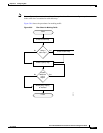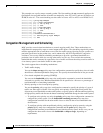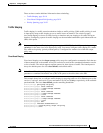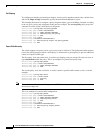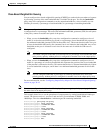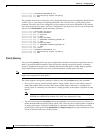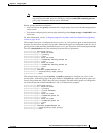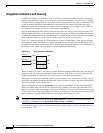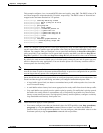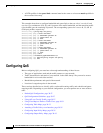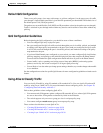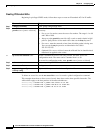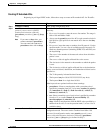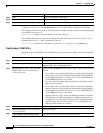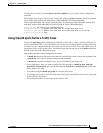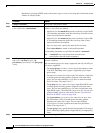
30-25
Cisco ME 3400 Ethernet Access Switch Software Configuration Guide
78-17058-01
Chapter 30 Configuring QoS
Understanding QoS
This example configures class A to match DCSP values and a policy map, PM1. The DSCP values of 30
and 50 are mapped to unique thresholds (32 and 64, respectively). The DSCP values of 40 and 60 are
mapped to the maximum threshold of 112 packets.
Switch(config)# class-map match-any classA
Switch(config-cmap)# match ip dscp 30 40 50 60
Switch(config-cmap)# exit
Switch(config)# policy-map PM1
Switch(config-pmap)# class classA
Switch(config-pmap-c)# bandwidth percent 50
Switch(config-pmap-c)# queue-limit 112
Switch(config-pmap-c)# queue-limit dscp 30 32
Switch(config-pmap-c)# queue-limit dscp 50 64
Switch(config-pmap-c)# exit
Switch(config-pmap)# exit
Switch(config)# interface gigabitethernet 0/1
Switch(config-if)# service-policy output PM1
Switch(config-if)# exit
Note When you configure a queue limit for a class in an output policy map, all other output policy maps must
use the same format of qualifier type and qualifier value. Only the queue-limit threshold values can be
different. For example, when you configure class A queue limit thresholds for dscp 30 and dscp 50 in
policy map PM1, if you configure class A queue limits in policy map PM2, you must use dscp 30 and
dscp 50 as qualifiers. You cannot use dscp 20 and dscp 40. Only the threshold values can be different.
By default, the total amount of buffer space is divided equally among all ports and all queues per port,
which is adequate for many applications. You can decrease queue size for latency-sensitive traffic or
increase queue size for bursty traffic.
Note When you use the queue-limit command to configure queue thresholds for a class, the WTD thresholds
must be less than or equal to the queue maximum threshold. A queue size configured with no qualifier
must be larger than any queue sizes configured with qualifiers.
Queue bandwidth and queue size (queue limit) are configured separately and are not interdependent. You
should consider the type of traffic being sent when you configure bandwidth and queue-limit:
• A large buffer (queue limit) can better accommodate bursty traffic without packet loss, but at the
cost of increased latency.
• A small buffer reduces latency but is more appropriate for steady traffic flows than for bursty traffic.
• Very small buffers are typically used to optimize priority queuing. For traffic that is priority queued,
the buffer size usually needs to accommodate only a few packets; large buffer sizes that increase
latency are not usually necessary. For high-priority latency-sensitive packets, configure a relatively
large bandwidth and relatively small queue size.
Note These restrictions apply to WTD qualifiers:
• You cannot configure more than two threshold values for WTD qualifiers (cos, dscp, precedence,
qos-group) by using the queue-limit command. However, there is no limit to the number of
qualifiers that you can map to these thresholds. You can configure a third threshold value to set the
maximum queue by using the queue-limit command with no qualifiers.



